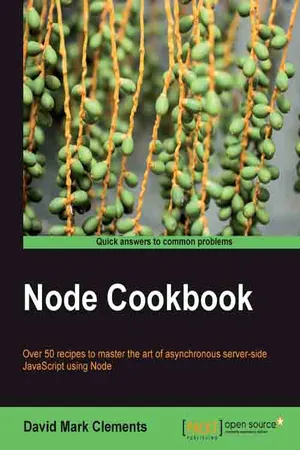![]()
![]()
Table of Contents
Node Cookbook
Credits
About the Author
About the Reviewers
www.PacktPub.com
Support files, eBooks, discount offers and more
Why Subscribe?
Free Access for Packt account holders
Preface
What this book covers
What you need for this book
Who this book is for
Conventions
Reader feedback
Customer support
Downloading the example code
Errata
Piracy
Questions
1. Making a Web Server
Introduction
Setting up a router
Getting ready
How to do it...
How it works...
There's more...
Simple multilevel routing
Parsing the querystring
Routing modules
See also
Serving static files
Getting ready
How to do it...
How it works...
There's more...
The favicon gotcha
See also
Caching content in memory for immediate delivery
Getting ready
How to do it...
How it works...
There's more...
Reflecting content changes
See also
Optimizing performance with streaming
Getting ready
How to do it...
How it works...
There's more...
Protecting against process memory overruns
See also
Securing against filesystem hacking exploits
Getting ready
How to do it...
How it works...
There's more...
Whitelisting
Node-static
See also
2. Exploring the HTTP Object
Introduction
Processing POST data
Getting ready
How to do it...
How it works...
There's more...
Accessing POST data with connect.bodyParser
See also
Handling file uploads
Getting ready
How to do it...
How it works...
There's more...
Using formidable to accept all POST data
Preserving filenames with formidable
Uploading via PUT
See also
Using Node as an HTTP client
Getting ready
How to do it...
How it works...
There's more...
Sending POST requests
Multipart file upload as a client
See also
Implementing download throttling
Getting ready
How to do it...
How it works...
Enabling resumes from broken downloads
See also
3. Working with Data Serialization
Introduction
Converting an object to JSON and back again
Getting ready
How to do it...
How it works...
There's more...
Constructing JSONP responses
Security and JSONP
See also
Converting an object to XML and back again
Getting ready
How to do it...
How it works...
There's more...
Objects containing arrays and functions
Generating XML attributes
Text values alongside attribute declarations
See also
Browser-server transmission via AJAX
Getting ready
How to do it...
How it works...
There's more...
Sending serialized data from client to server
See also
Working with real data: fetching trending tweets
Getting ready
How to do it...
How it works...
Twitter API and the User-Agent header
There's more...
Cross referencing Google Hot Trends with Twitter tweets
See also
4. Interfacing with Databases
Introduction
Writing to a CSV file
Getting ready
How to do it...
How it works...
There's more...
Customizing the CSV elements
Reading a CSV file
Manipulating CSV as a stream
See also
Connecting and sending SQL to a MySQL server
Getting ready
How to do it...
How it works...
There's more...
Using and cleaning user input
Receiving results from the MySQL server
See also
Storing and retrieving data with MongoDB
Getting ready
How to do it...
How it works...
There's more...
Indexing and aggregation
Updating modifiers, sort, and limit
See also
Storing and retrieving data with Mongoskin
Getting ready
How to do it...
How it works...
There's more...
Collection binding
See also
Storing data to CouchDB with Cradle
Getting ready
How to do it...
How it works...
There's more...
Scaling CouchDB with BigCouch
See also
Retrieving data from CouchDB with Cradle
Getting ready
How to do it...
How it works...
There's more...
Creating an admin user
Locking all modifying operations to an admin user
Exposing the CouchDB HTTP interface to remote connections
See also
Accessing CouchDB changes stream with Cradle
Getting ready
How to do it...
How it works...
See also
Storing and retrieving data with Redis
Getting ready
How to do it...
How it works...
There's more...
Speeding up node Redis module
Overcoming network latency by pipelining commands
See also
Implementing PubSub with Redis
Getting ready
How to do it...
How it works...
There's more...
Redis authentication
Securing Redis from external connections
See also
5. Transcending AJAX: Using WebSockets
Introduction
Creating a WebSocket server
Getting ready
How to do it...
How it works...
There's more...
Supporting older Firefox browsers
Creating a node-based WebSocket client
See also
Seamless fallbacking with socket.io
Getting ready
How to do it...
How it works...
There's more...
Custom events
Namespaces
See also
Callbacks over socket.io transport
Getting ready
How to do it...
How it works...
There's more...
Shared functions with Nowjs
See also
Creating a real-time widget
Getting ready
How to do it...
How it works...
There's more...
Preparing for scalability
WebSockets as a development tool
See also
6. Accelerating Development with Express
Introduction
Generating Express scaffolding
Getting ready
How to do it...
How it works...
There's more...
Picking apart app.js
Looking into routes/index.js
See also
Defining and applying environments
Getting ready
How to do it...
How it works...
There's more...
Setting other environments
Changing NODE_ENV permanently
See also
Dynamic routing
Getting ready
How to do it...
How it works...
There's more...
Route validation
Optional routes
Asterisks wildcards
See also
Templating in Express
Getting ready
How to do it...
How it works...
There's more...
Using other template eng...
